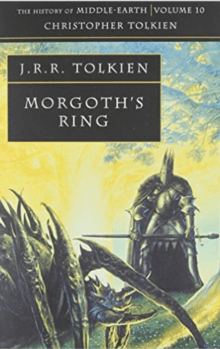Morgoth's Ring
 | |
| Editor | Christopher Tolkien |
|---|---|
| Author | J. R. R. Tolkien |
| Country | United Kingdom |
| Language | English |
| Genre |
High fantasy Literary analysis |
| Publisher | George Allen & Unwin (UK) |
Publication date | 1993 |
| Media type | Print (hardback and paperback) |
| Pages | 496 (paperback) |
| ISBN | 978-0261103009 |
| Preceded by | Sauron Defeated |
| Followed by | The War of the Jewels |
| The History of Middle-earth |
|---|
Morgoth's Ring (1993) is the tenth volume of Christopher Tolkien's 12-volume series The History of Middle-earth in which he analyses the unpublished manuscripts of his father J. R. R. Tolkien. This volume, along with the subsequent The War of the Jewels, provides detailed writings and editorial commentary pertaining to J. R. R. Tolkien's cosmology that eventually would become The Silmarillion. This book mentions a few characters excluded elsewhere, including Findis and Irimë, the daughters of Finwë.
The title of this volume comes from a statement from one of the essays: "Just as Sauron concentrated his power in the One Ring, Morgoth dispersed his power into the very matter of Arda, thus 'the whole of Middle-earth was Morgoth's Ring'".
Contents
Morgoth's Ring presents source material and editorial on the following:
- Later (1951) revisions of The Silmarillion, showing Tolkien's drastic revisiting and rewriting of his legends.
- "Annals of Aman" — detailed chronology from the creation of the world through to the end of the First Age, including an explanation of time reckoning in Valian Years.
- "Laws and Customs among the Eldar" — several essays and legends on the Eldar, particularly mating and naming customs of the Elves, and Tolkien's conceptions of the soul and body.
- "Athrabeth Finrod ah Andreth" — A discussion between two characters, an Elven king Finrod Felagund and Andreth, a mortal woman, about the tragedy of death and immortality, and the way Elves and Men suffer their different sorrows; and about the healing of death by the Resurrection and the Incarnation.
- "Tale of Adanel" — the Middle-earth version of the tale of original sin, included in "Athrabeth", being told by Andreth to Finrod as a story about the past of Men.
- "Myths Transformed" — several fragments on Morgoth, Sauron, and the origin of the Orcs. This section is frequently cited in discussions concerning the Tolkien legendarium, and represents the author's later-evolved views on some central topics.
The Annals of Aman
The Annals of Aman date to the period following the completion of The Lord of the Rings. There are three extant versions of the text, including a carefully emended manuscript, a typescript and its carbon copy each featuring different corrections and notes, and a typescript of the earlier sections of the text that deviates from the previous typescript. Christopher Tolkien surmises that the first typescript was composed in 1958.
A reworking of the earlier Annals of Valinor (which was the working title of the manuscript until Tolkien changed it) and connected closely with the narrative of the incomplete 1937 Quenta Silmarillion, The Annals of Aman moves from a compressed narrative style to a fuller accounting of the events of the chronology.
The Annals of Aman presents the history of the world from the entry of the Valar into Arda until the Hiding of Valinor after the revolt and exile of the Noldor in the form of year-by-year entries of varying lengths, much in the style of real-world annals. Tolkien attributes the work to the Noldorin lore-master and linguist Rúmil of Tirion. According to the second typescript, The Annals of Aman were remembered by the Noldorin Exiles in Middle-earth, who transmitted their knowledge to the Men of Númenor, whence it eventually reached Arnor and Gondor.
Title page
The title page of each volume of The History of Middle-earth displays an inscription in the Fëanorian characters (Tengwar, an alphabet devised by Tolkien for High-elven), written by Christopher Tolkien and describing the contents of the book. The inscription in Book X reads: "In this book are given many of the later writings of John Ronald Reuel Tolkien concerning the history of the Elder Days from the Music of the Ainur to the Hiding of Valinor; here much is told of Sun and the Moon; of the immortal Eldar and the death of the Atani; of the beginning of the Orcs and of the evil power of Melkor, the Morgoth, the Black Foe of the World."
See also
References
- J. R. R. Tolkien (1993). Christopher Tolkien, ed. Morgoth's Ring. Boston & New York: Houghton Mifflin. ISBN 0-395-68092-1.